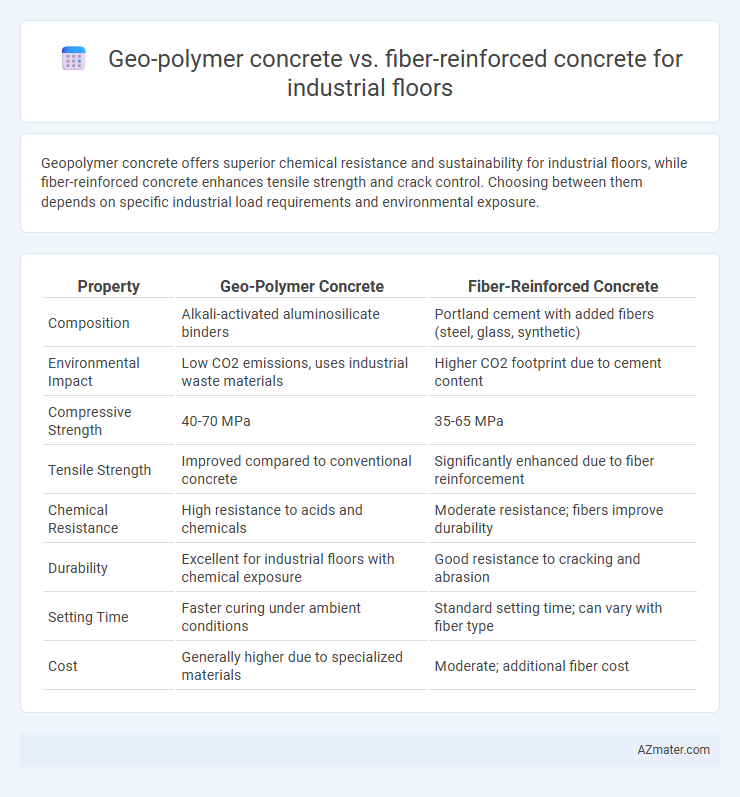Geopolymer concrete offers superior chemical resistance and sustainability for industrial floors, while fiber-reinforced concrete enhances tensile strength and crack control. Choosing between them depends on specific industrial load requirements and environmental exposure.
Table of Comparison
| Property | Geo-Polymer Concrete | Fiber-Reinforced Concrete |
|---|---|---|
| Composition | Alkali-activated aluminosilicate binders | Portland cement with added fibers (steel, glass, synthetic) |
| Environmental Impact | Low CO2 emissions, uses industrial waste materials | Higher CO2 footprint due to cement content |
| Compressive Strength | 40-70 MPa | 35-65 MPa |
| Tensile Strength | Improved compared to conventional concrete | Significantly enhanced due to fiber reinforcement |
| Chemical Resistance | High resistance to acids and chemicals | Moderate resistance; fibers improve durability |
| Durability | Excellent for industrial floors with chemical exposure | Good resistance to cracking and abrasion |
| Setting Time | Faster curing under ambient conditions | Standard setting time; can vary with fiber type |
| Cost | Generally higher due to specialized materials | Moderate; additional fiber cost |
Introduction to Advanced Concrete Technologies
Geo-polymer concrete offers exceptional durability and chemical resistance, making it ideal for industrial floors exposed to harsh environments. Fiber-reinforced concrete enhances tensile strength and crack control, improving load-bearing capacity and longevity under dynamic industrial loads. Advanced concrete technologies integrate these materials to optimize performance, sustainability, and maintenance costs in industrial flooring applications.
Overview of Geo-Polymer Concrete
Geo-polymer concrete is an environmentally friendly alternative to traditional concrete, utilizing industrial by-products like fly ash or slag combined with alkaline activators to form a binder that reduces carbon emissions significantly. It offers high chemical resistance, excellent durability, and rapid strength gain, making it suitable for industrial floors subjected to heavy loads and aggressive environments. Its lower thermal conductivity and enhanced resistance to fire and corrosion provide long-lasting performance compared to fiber-reinforced concrete, which primarily improves tensile strength and crack resistance.
Fundamentals of Fiber-Reinforced Concrete
Fiber-reinforced concrete (FRC) incorporates fine or coarse fibers such as steel, glass, or synthetic materials to enhance tensile strength, durability, and crack resistance, which are critical for industrial floor performance. Unlike geo-polymer concrete that relies on aluminosilicate chemistry for eco-friendly binding, FRC improves mechanical properties through the physical action of fibers distributing stress and limiting crack propagation. The fundamental advantage of FRC in industrial flooring lies in its ability to withstand heavy loads and dynamic impacts while maintaining structural integrity over time.
Material Composition and Sustainability Comparison
Geopolymer concrete for industrial floors is primarily composed of industrial by-products like fly ash or slag activated with alkaline solutions, offering lower carbon emissions compared to traditional OPC-based fiber-reinforced concrete, which incorporates Portland cement combined with fibers such as steel, glass, or polypropylene for enhanced tensile strength and crack resistance. The sustainability advantage of geopolymer concrete lies in its reduced reliance on cement and utilization of waste materials, significantly lowering the embodied carbon footprint and energy consumption during production. Fiber-reinforced concrete, while improving durability and reducing maintenance, typically has a higher environmental impact due to cement production and fiber manufacturing processes.
Mechanical Properties: Strength and Durability
Geo-polymer concrete exhibits high compressive strength and superior chemical resistance, making it ideal for industrial floors exposed to harsh chemicals and heavy loads. Fiber-reinforced concrete enhances tensile strength and crack resistance through the inclusion of synthetic or steel fibers, improving durability under dynamic and impact stresses in industrial environments. Both materials offer unique mechanical advantages, with geo-polymer concrete excelling in chemical durability and fiber reinforcement optimizing toughness and flexural performance.
Industrial Floor Performance: Load-Bearing and Impact Resistance
Geopolymer concrete offers superior load-bearing capacity and excellent chemical resistance, making it ideal for heavy industrial floors exposed to harsh conditions. Fiber-reinforced concrete enhances impact resistance and crack control through its embedded fibers, providing improved toughness under dynamic loads. Combining fiber reinforcement with geopolymer matrices can optimize industrial floor performance by balancing strength, durability, and resilience against heavy machinery and repetitive impacts.
Resistance to Chemicals and Environmental Factors
Geopolymer concrete exhibits superior resistance to chemicals and harsh environmental factors due to its inorganic polymer matrix, which offers enhanced durability against acids, alkalis, and sulfates commonly found in industrial settings. Fiber-reinforced concrete improves tensile strength and crack resistance but may have reduced chemical resistance depending on the fiber type and concrete composition. For industrial floors exposed to aggressive chemicals and extreme conditions, geopolymer concrete provides a longer service life and lower maintenance costs.
Installation Techniques and Construction Efficiency
Geo-polymer concrete uses alkaline activators to cure, allowing faster setting times and reduced curing periods compared to fiber-reinforced concrete, which often requires longer curing for optimal fiber bonding. Installation of geo-polymer concrete involves precise mixing of industrial by-products like fly ash and slag that demand controlled conditions, promoting efficient layering and reduced labor on industrial floors. Fiber-reinforced concrete requires uniform fiber dispersion and careful vibration to prevent clumping, which can slow construction but improves tensile strength and crack resistance post-installation.
Cost Analysis and Lifecycle Assessment
Geo-polymer concrete offers a lower carbon footprint and reduced long-term maintenance costs compared to fiber-reinforced concrete, making it a cost-effective solution for industrial floors with sustainable benefits. Fiber-reinforced concrete provides superior tensile strength and crack resistance, potentially extending durability and decreasing repair frequency, but often entails higher initial material and installation expenses. Lifecycle assessments reveal that geo-polymer concrete's eco-friendly components and reduced energy consumption during production can offset higher upfront costs over time, enhancing overall economic and environmental value.
Future Trends in Industrial Flooring Solutions
Geo-polymer concrete offers enhanced chemical resistance and lower carbon emissions, making it a sustainable choice for industrial flooring, while fiber-reinforced concrete provides superior tensile strength and crack control in heavy-duty applications. Future trends indicate a growing integration of nano-materials and improved fiber technologies to further boost durability and lifespan. Emphasis on eco-friendly materials and multifunctional flooring solutions will drive innovation in industrial flooring systems.

Infographic: Geo-polymer concrete vs Fiber-reinforced concrete for Industrial floor
 azmater.com
azmater.com